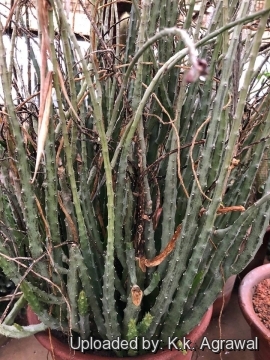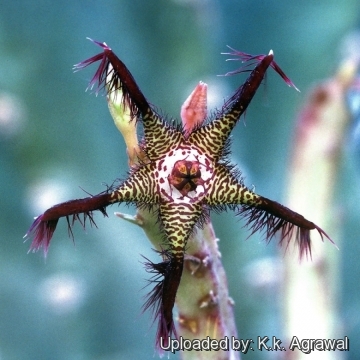
Caralluma adscendens var. fimbriata Photo by: K.k. Agrawal
Origin and Habitat: Caralluma adscendensSN|31341]]SN|31341]] var. fimbriata is found in peninsular India (Dekkan Peninsula, from the Konkan southwards), and also Sri Lanka and in the Ava district of Burma.
Habitat and ecology: Arid rocky places.
Synonyms:
See all synonyms of Caralluma adscendens
back
Accepted name in llifle Database:Caralluma adscendens var. fimbriata (Wall.) GravelyInd. Sp. Gen. Car. 13 1931.Synonymy: 2
Accepted name in llifle Database:Caralluma adscendens (Roxb.) Haw.Syn. Pl. Succ. 47. 1812Synonymy: 4
Accepted name in llifle Database:Caralluma adscendens var. attenuata (Wight) Gravely & Mayur.Bull. Madras Gov. Mus. ser. nov., 4(1): 13. 1931Synonymy: 2
Accepted name in llifle Database:Caralluma adscendens var. carinata Gravely & Mayur.Bull. Madras Gov. Mus. n.s., 4(1): 16 (t. I, fig. 11, t. II, fig. 6). 1931 [Apr 1931]Synonymy: 2
Accepted name in llifle Database:Caralluma adscendens var. geniculata Gravely & Mayur.Bull. Madras Gov. Mus. n.s., 4(1): 16 (t. I, fig. 7, t. II, figs. 7-8). 1931 [Apr 1931]Synonymy: 2
Accepted name in llifle Database:Caralluma adscendens var. gracilis Gravely & Mayur.Bull. Madras Gov. Mus. . n.s., 4(1): 14 (-15; t. I, fig. 8, t. II, fig. 5). 1931 [Apr 1931]Synonymy: 2
back
Common Names include:
KANNADA (ಕನ್ನಡ): Maakada singi, Mangana kodu
MARATHI (मराठी): माकड शिंग Makad Shing
SANSKRIT (संस्कृतम्): Yugmaphallottama
TAMIL (தமிழ்): Cullí mulayan, Kullee Mooliyan, Kallimudayan
TELUGU (తెలుగు): Kaarallamu, Kundelu kommulu
Description: Caralluma adscendensSN|31341]]SN|31341]] var. fimbriata (Caralluma fimbriataSN|33097]]SN|33097]]) differs from var. adscendens for its stems (at least close to the base) with rounded edges. The flowers are rather small, drooping frilly with hairs similar to Caralluma adscendensSN|31341]]SN|31341]] var. attenuata.
Derivation of specific name: Latin 'fimbria', thread, fringe; and Latin '-fer, -fera, -ferum', -carrying; for the hairs on the corolla lobes.
Habit: It is an erect shrubby perennial herb, 12-20 cm tall, usually dichotomously branched, with xerophytic features and cactus-like appearance. The stems are fleshy almost leafless, green, often with brownish streak.
Stems: Stemlets leafless, creeping at first, then upright, tapering towards the apex and only, green, often striped brownish, four-angled, edges rounded slightly sinuate-dentate. Tubercles blunt, protruding, horizontally spreading. Sap watery.
Leaves: Rudimentary, minute tooth-like, present only on young branches, soon falling off, leaving a tooth-like projection on the angles.
Inflorescences: Borne at the end of branches, 1- to 3-flowered in the leaf-axils, loosely scattered.
Flowers: About 20 mm across, drooping on short stalks bent downwards. Corolla rotate, lobes narrow, purple with yellow marking, and margins frilly with hairs.
Blooming season (in habitat): July-August.
Fruits (follicles): Paired, slender, 10-12 cm long, cylindric with one of the pairs often suppressed, round in cross section, green with purple streaks, tapering towards apex.
Seeds: Comose.
Subspecies, varieties, forms and cultivars of plants belonging to the Caralluma adscendens group
- Caralluma adscendens (Roxb.) Haw.: (var. adscendens) Stems edges rounded or sharp; Tubrcles blunt, protruding, horizontally spreading; Flowers drooping; Corolla green, dotted with purple, lobes brownish, spreading outwards, glabrous. Distribution: widespread in India, Ceylon and Burma.
- Caralluma adscendens var. attenuata (Wight) Gravely & Mayur.: Tubercles strongly bent upwards; Flower not quite as drooping as in var. adscendens and var. fimbriata; Pedicel horizontally spreading; Corolla 1.5 cm in diameter, hairy. Distribution: widespread in Indian sub-continent.
- Caralluma adscendens var. carinata Gravely & Mayur.: stem often unhranched, edges acute; Tubercles as in var. attenuata; Flowers erect; Pedicel horizontally spreading; Corolla purple, lobes light maroon banded with yellow. Intermediate between var. attenuata and var. fimbriata in habit. Distribution: India.
 Caralluma adscendens var. fimbriata (Wall.) Gravely: Stems (at least close to the base) with rounded edges: Tubercles as in var. attenuata; corolla rather small, similar to var. attenuata. Distribution: India, Sri Lanka and Burma.
Caralluma adscendens var. fimbriata (Wall.) Gravely: Stems (at least close to the base) with rounded edges: Tubercles as in var. attenuata; corolla rather small, similar to var. attenuata. Distribution: India, Sri Lanka and Burma. - Caralluma adscendens var. geniculata Gravely & Mayur.: stems ascending-erect, occasionally branched. Tubercles indistinctly set off. Pedicel ascending or horizontally spreading. Corolla yellow striped with dark-brown, tube opening widely. It is more related to Caralluma bhupinderiana. Distribution: India.
- Caralluma adscendens var. gracilis Gravely & Mayur.: Stems very slender and strongly branched with acute edges; inflorescence with 2 erect Flowers; Pedicels long, slender, ascending. Corolla lobes strongly revolute. Distribution: India.
- Caralluma dalzielii N.E.Br.: Distribution: Africa North of the equator (Sahelian zone in Africa east to Somalia).
 Caralluma subulata (Forssk.) Decne.: Distribution: Arabian Peninsula.
Caralluma subulata (Forssk.) Decne.: Distribution: Arabian Peninsula.
Bibliography: Major references and further lectures
1) Debasis Bagchi, Harry G. Preuss "Obesity: Epidemiology, Pathophysiology, and Prevention" Second Edition CRC Press, 06 July 2012
2) Focke Albers, Ulrich Meve "Illustrated Handbook of Succulent Plants: Asclepiadaceae: Asclepiadaceae" Volume 4 Springer, 2002
3) Hermann Jacobsen "A Handbook of Succulent Plants: Descriptions, Synonyms, and Cultural Details for Succulents Other Than Cactaceae" Volume 1 Blandford Press, 1960
4) George Watt "A Dictionary of the Economic Products of India" Volume 2 Cambridge University Press, 23 january 2014
5) T. M. Ramakrishna, S. N. Ramaswamy, Govindappa D. Arekal "The Asclepiadaceae and Periplocaceae of Karnataka" Prasaranga, University of Mysore, 1995
6) Umberto Quattrocchi "CRC World Dictionary of Medicinal and Poisonous Plants: Common Names, Scientific Names, Eponyms, Synonyms, and Etymology" CRC Press, 03 May 2012
7) R. P. Sharma, Business Manager, Indian Forester. "The Indian Forester" Volume 125 1999
8) "Plants of the Coast of Coromandel" 1: 28-29, t. 30. 1795
9) "Memoirs of the Wernerian Natural History Society" 1: 25. 1810
10) "Synopsis plantarum succulentarum" 47. 1812
11) "Taxon" 30: 696. 1981
12) "Journal of Pharmacy Research" 2(7): 1228-1229. 2009
13) "Studies in Natural Products Chemistry" Volume 40 Newnes, 25 June 2013
14) "Bradleya: Yearbook of the British Cactus and Succulent Society" Volune 10: 95 The Society, 1992
15) "Journal of Non-timber Forest Products", Volumi 7-9 Bishen Singh Mahendra Pal Singh, 2000
16) Wikipedia contributors. "Caralluma adscendens." Wikipedia, The Free Encyclopedia. Wikipedia, The Free Encyclopedia, 28 Jun. 2015. Web. 16 Jul. 2015.
17) Flowers of India contributors "Caralluma adscendens var. fimbriata" http://www.flowersofindia.net - Identification credit: Prashant Awale Web. 16 Jul. 2015.
 Caralluma adscendens var. fimbriata Photo by: K.k. Agrawal
Caralluma adscendens var. fimbriata Photo by: K.k. Agrawal Caralluma adscendens var. fimbriata Photo by: K.k. Agrawal
Caralluma adscendens var. fimbriata Photo by: K.k. Agrawal Caralluma adscendens var. fimbriata Photo by: K.k. Agrawal
Caralluma adscendens var. fimbriata Photo by: K.k. AgrawalSend a photo of this plant.The gallery now contains thousands of pictures, however it is possible to do even more. We are, of course, seeking photos of species not yet shown in the gallery but not only that, we are also looking for better pictures than those already present.
Read More... Cultivation and Propagation: Caralluma adscendensSN|31341]]SN|31341]] var. fimbriata is a relatively quick-growing species and not as difficult to cultivate as was originally thought. It can stand drought for quite a period, which is the only time when it loose its leaves. Keep dry in Winter. Water a little more than other succulents in Summer.
Traditional uses: This species has been in use for centuries in India. It is commonly used as a vegetable in semiarid regions of India. It is eaten raw or cooked with spices, or preserved in chutneys and pickles, and is often found as a roadside shrub or boundary marker. It is also classified as famine food. In arid and semiarid regions, when no food is available, this is consumed as a substitute for food. Indians are known to chew chunks of Caralluma adscendensSN|31341]]SN|31341]] var. fimbriata) to suppress hunger when on a day's hunt. The cactus is used by the South Indians to suppress appetite and enhance endurance. They make their living as hunters, wood collectors, plant collectors, foragers, etc. They do not eat or carry cooked food with them while they go into the forests for hunting. To ensure that they are not hungry and that they have enough endurance to last them on their forays into the forest, they chop off the stems of this succulent and chew a handful of them. By doing so, they do not feel hungry and thirsty. They can hunt and stay out for hours together without food or water. The tribesmen also state that their energy levels are maintained without food and water and that they do not feel any fatigue or tiredness. In a day, the consumption of C. adscendens var. fimbriata as a vegetable in the manner used by the tribesmen was about 100 g. C. adscendens var. fimbriata and Hoodia gordoniiSN|10582]]SN|10582]] received a growing interest in the past 20 years because it was claimed that they presented appetite-suppressant and weight loss properties. The bioactive compounds that were isolated from C. adscendens var. fimbriata and H. gordonii were glycosteroids, specifically 14b-hydroxypregnane derivatives.
Medical uses: Anti inflammatory, antipyretic, antinociceptive, antifungal, antidote and anthelmintic, used in treatment of rheumatism, diabetes, leprosy, tumour, fungal diseases, snake, scorpion bite. Young stem ground with onion and tamarind and made into a paste used to cure digestive problems.













